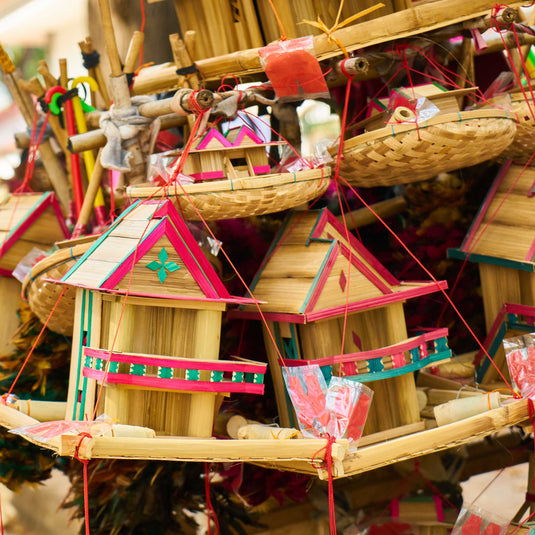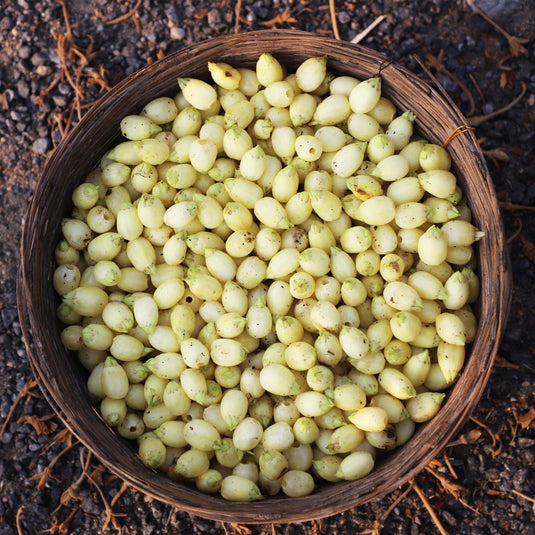Honeybees collect the nectar (sweet liquid) from flowers of the plants to make honey. The properties (taste, texture, color etc) of honey is directly depends on the type of flower foraged by the honeybee.
For example- If honeybees collect the nectar of Mustard flower to make honey, then honey will be light brown in color, high glucose content, sweet, high viscosity (thick) and tendency of crystallization of honey will be very high.
If honeybees collect the nectar of Kalshi flower (Sundarbans) to make honey then honey will be light brown in color with a note of very light vinegary taste, medium glucose content, low viscosity and tendency of crystallization of honey will be very low.
If honeybees collect the nectar of Gokhul and Amora flower (Saranda Forest) to make honey then honey will be almost black in color, smoky woody in taste, medium glucose to fructose ratio, high viscosity and tendency of crystallization of honey will be very low.
Similarly, if honeybees collect the nectar of Van Tulsi flower (Kashmir Valley) to make honey then honey will be very light brown / almost transparent in color, very smooth and mild sweet, medium viscosity and tendency of crystallization of honey will be medium.
Sometimes honey can become thick and grainy, with visible crystals forming in the jar. This process is known as crystallization, and it occurs when the natural sugars in honey form into a solid state. In this article, we will explore why honey crystalizes and how to prevent it.
Firstly, it is important to understand that all honey has the potential to crystalize. However, some types of honey are more prone to crystallization than others. Honey with a high glucose to fructose ratio, such as clover honey, is more likely to crystallize than honey with a low glucose to fructose ratio, such as acacia honey. This is because glucose is more likely to form crystals than fructose.
Secondly, temperature plays a significant role in honey crystallization. Honey is a supersaturated solution, meaning that it contains more sugar than would normally dissolve in water at room temperature. When honey is exposed to colder temperatures, some of the sugar molecules come out of solution and begin to form crystals. Conversely, when honey is exposed to warmer temperatures, the sugar molecules dissolve again and the honey becomes liquid.
Another factor that can contribute to honey crystallization is the presence of small particles in the honey, such as pollen grains or air bubbles. These particles can act as a nucleus for the sugar molecules to attach to, speeding up the crystallization process.
It is also worth noting that some honey may have been intentionally crystallized by the beekeeper. This is done by gently heating the honey to dissolve the crystals, and then cooling the honey slowly to encourage them to reform. Crystallized honey has a thicker consistency and is less likely to drip or run, making it easier to use in cooking and baking.
While crystallization can be a natural process, it can also affect the texture and appearance of the honey, making it less appealing to consumers. However, there are several ways to prevent honey from crystallizing or to reverse the process if it has already occurred.
One way to prevent honey from crystallizing is to store it at room temperature. Keeping honey in a warm place will slow down the process of crystallization. If you want to keep honey for a longer period, it is best to store it in an airtight container in a cool, dark place, such as a pantry or cupboard. However, avoid storing honey in the fridge, as this will accelerate the crystallization process.
Another way to prevent honey from crystallizing is to filter it before storing. Straining the honey will remove any small particles that could act as a nucleus for the sugar molecules to attach to. This will slow down the crystallization process and keep the honey smooth and liquid for longer.
If your honey has already crystallized, there are several ways to reverse the process. One method is to gently warm the honey by placing the jar in a warm water bath. Be careful not to overheat the honey, as this can destroy some of its beneficial enzymes and antioxidants.
Another method is to stir the honey vigorously, which will break up the crystals and redistribute the sugar molecules. However, be aware that this method may not work for all types of honey and could potentially introduce air bubbles into the honey.
In conclusion, honey crystallization is a natural process that occurs when the natural sugars in honey form into a solid state. While all honey has the potential to crystallize, some types of honey are more prone to crystallization than others. Temperature, small particles, and glucose to fructose ratio are all factors that can contribute to honey crystallization. However, by storing honey at room temperature, filtering it before storing, and gently warming it if it has already crystallized, you can prevent or reverse the process and enjoy smooth, delicious honey for longer.
Just like wine, there is an incredible and huge variety of flavors and colors in honey, depending on its origin.
(Crystallization of honey is very normal, it completely depends on the flora of the region and glucose and fructose ratio in the honey. It can also vary from one honey hive to another honey hive within same forest region and same season)


